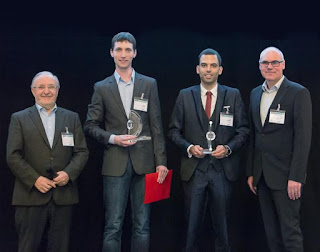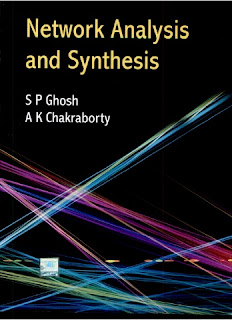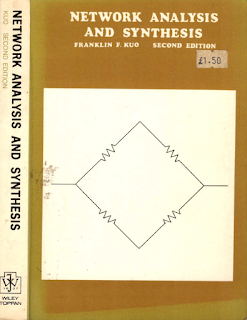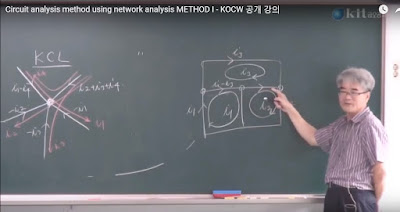domingo, 10 de junho de 2018
Compact DC-AC SiC Inverter for High Ambient Temperatures in Hybrid Electric Vehicles- ETH Zurich Power Electronic Systems Laboratory
Compact DC-AC SiC Inverter for High Ambient Temperatures in Hybrid Electric Vehicles
Power electronic converters are key components of Hybrid Electric Vehicles, which are in the core focus of the Research and Development activities of the automotive industry. Today’s converters feature Silicon power semiconductors with a junction temperature limit between 150 °C and 175 °C and thus their operating ambient temperature range is limited to values typically well below 80 °C. This implies undesired restrictions regarding cooling circuit requirements or the placement of the converter due to the ambient air temperature level in case of air-cooled converters.Silicon Carbide (SiC) power semiconductor switches allow to increase the junction temperature beyond 175 °C and thus to overcome the above mentioned restrictions. In this research project, an ambient-air-cooled, high power density SiC inverter system for an ambient air temperature level of 120 °C is investigated. In order to be able to fully utilize the semiconductors, the converter is designed for an optimum junction temperature of 250 °C. A high switching frequency of 50 kHz keeps volume and weight of passive components low and covers a broad range of output frequencies suitable even for driving high-speed electrical machines. It is made sure that the individual devices are operated within their specified temperature ranges by carefully choosing the component placing taking needs from an electrical point of view into account and by active Peltier cooling of the components. Some components, such as high performance fans for the air-cooling system, are currently not available on the market in the required temperature range and thus are developed as an additional part of this project. All obtained results are experimentally validated on a test high speed test bench with a 10 kW permanent magnet synchronous machine and an induction machine rotating up to 30’000 rpm.
Power Electronics Systems Laboratory DC-AC Converters
Dr. Benjamin Wrzecionko Contact ETH Zurich Power Electronic Systems Laboratory Physikstrasse 3 ETL H23 8092 Zurich Switzerland
LINK
https://www.ethz.ch/content/specialinterest/itet/power-electronic-systems-lab/en/research/research-and-thesis-projects/dc-ac-converters/DC-AC-Converters-1.html
WIRELESS CHARGING OF ELECTRIC VEHICLES Omer C. Onar, Steven Campbell, Larry Seiber, Cliff White Power Electronics and Electric Machinery Group (PEEM) Electrical and Electronics Systems Research Division (EESR)
Oak Ridge National Laboratory Wireless Charging of Electric Vehicles – CRADA Report WIRELESS CHARGING OF ELECTRIC VEHICLES
Omer C. Onar, Steven Campbell, Larry Seiber, Cliff White, Madhu Chinthavali, Lixin Tang, Paul Chambon, and Burak Ozpineci Power Electronics and Electric Machinery Group (PEEM) Electrical and Electronics Systems Research Division (EESR)
1. Abstract Wireless power transfer (WPT) is a paradigm shift in electric-vehicle (EV) charging that offers the consumer an autonomous, safe, and convenient option to conductive charging and its attendant need for cables. With WPT, charging process can be fully automated due to the vehicle and grid side radio communication systems, and is non-contacting; therefore issues with leakage currents, ground faults, and touch potentials do not exist. It also eliminates the need for touching the heavy, bulky, dirty cables and plugs. It eliminates the fear of forgetting to plug-in and running out of charge the following day and eliminates the tripping hazards in public parking lots and in highly populated areas such as shopping malls, recreational areas, parking buildings, etc. Furthermore, the high-frequency magnetic fields employed in power transfer across a large air gap are focused and shielded, so that fringe fields (i.e., magnetic leakage/stray fields) attenuate rapidly over a transition region to levels well below limits set by international standards for the public zone (which starts at the perimeter of the vehicle and includes the passenger cabin). Oak Ridge National Laboratory’s approach to WPT charging places strong emphasis on radio communications in the power regulation feedback channel augmented with software control algorithms. The over-arching goal for WPT is minimization of vehicle on-board complexity by keeping the secondary side content confined to coil tuning, rectification, filtering, and interfacing to the regenerative energy-storage system (RESS). This report summarizes the CRADA work between the Oak Ridge National Laboratory and the Toyota Research Institute of North America, Toyota Motor Engineering and Manufacturing North America (TEMA) on the wireless charging of electric vehicles which was funded by Department of Energy under DE-FOA-000667. In this project, ORNL is the lead agency and Toyota TEMA is one of the major partners. Over the course of the project, ORNL and Toyota TEMA worked closely on the vehicle integration plans, compatibility, and the interoperability of the wireless charging technology developed by ORNL for the vehicles manufactured by Toyota. These vehicles include a Toyota Prius Plug-in Hybrid electric vehicle, a Scion iQ electric vehicle, and two Toyota RAV4 electric vehicles. 2. Statement of Objectives The main objective of this project is to coordinate multi-party team for the design, development, and fabrication of WPT grid side unit (GSU), coupling coils, and the vehicle side power conditioning units. The GSU includes the active front-end rectifier with power factor correction (PFC), high-frequency power inverter, and the high-frequency isolation transformer whereas vehicle side unit includes a resonant tuning capacitor, a bridge rectifier, a filter circuit, and the additional relays and contactors that are used to timely respond to the charging request or to comply with the charging protocols that a vehicle may have (CHAdeMO, J1772, or direct battery connection). The objective of this work is to demonstrate a fully automated charging process including the alignment, start charging, stop charging, and the emergency and orderly shutdown procedures while meeting at least 6.6kW power transfer over 160mm magnetic airgap while exceeding an overall (end-to-end) efficiency of 85%. After integrating ORNL developed WPT technology into demonstration vehicles, an additional objective was to validate the system operation in an independent testing laboratory (Idaho National Laboratory) for field testing of this technology which will assist in system improvements and standards development. In this project, Evatran was the commercialization partner and under ORNL guidance worked on cost and component optimization and fabrication of GSUs and also the primary and secondary coils. Evatran also worked on vehicle integrations in coordination with ORNL and other partners. Clemson University ICAR Center was the demonstration site for phase #2 deliverables of the project. Clemson University, in collaboration with Cisco Systems, also supported the radio communications developments and radio integrations to the vehicles and the WPT equipment on the vehicles. Finally, Toyota Motor Corporation is the vehicle OEM partner provided the vehicles and collaborated with ORNL on the vehicle integrations. One last objective of this project was to demonstrate in-motion wireless charging on Toyota RAV4 vehicles to prove feasibility and collect data.
LINK FULL PAPER
https://info.ornl.gov/sites/publications/files/Pub68349.pdf
SEMIKRON Innovation Award 2018 & Young Engineer Award 2018
Press release
SEMIKRON Foundation and ECPE honour Mr. Stefan Matlok with the Innovation Award 2018 and Mr. Diogo Varajão for his work with the Young Engineer Award
Stuttgart, Germany, March 22nd 2018
The jury has decided to give the SEMIKRON Innovation Award 2018 to Stefan Matlok from Fraunhofer IISB in Erlangen, Germany for his outstanding work on ‘Zero Overvoltage Switching "ZOS"’
Abstract:
In power electronics turning off an electrical path is causing trouble by parasitic inductance leading to oscillations and voltage overshoot. The novel Zero Overvoltage Switching (ZOS) method offers the possibility to unleash unlimited switching speed in real-world applications without overvoltage on the semiconductors. Moreover, in best case, it is even avoiding any subsequent parasitic oscillation. The idea is to use the intrinsic parasitic inductances and parasitic capacities to build up a resonant circuit. The turn off event excites the resonant circuit and the free-wheeling diode stops it automatically after half a period, e.g. after a view nanoseconds. These resonant parasitic elements are thereby utilized to switch off a fixed current in a nearly lossless, overvoltage- and EMI compliant way. By designing the circuit and parasitics properly, there is no extra component necessary as parasitic inductance is now functional part of the topology.
The SEMIKRON Young Engineer Award 2018 is given to Mr Diogo Varajão
from AddVolt AS in Porto, Portugal for his contributions on ‘ACDC CUBE: Single-stage Bidirectional and Isolated AC-DC Matrix Converter for Battery Energy Storage Systems’
Abstract:
The ACDC CUBE technology consists in a new modulation and control strategy for the high-frequency link matrix converter. The matrix converter is a key element of the system, since it performs a direct AC to AC conversion between the grid and the power transformer, dispensing the traditional DC-link capacitors. Hence, the circuit volume and weight are reduced and a longer service life is expected when compared with the existing technical solutions. The innovation was validated through a prototype tested in the laboratory. Experimental results demonstrate the capability to control the grid currents in the synchronous reference frame in order to provide services for the grid operator. Additionally, the battery current is well regulated with small ripple which makes this converter appropriate for battery charging of EVs and energy storage applications.
Photo: (f. l. to r.) Prof. Leo Lorenz (ECPE), Stefan Matlok, Diogo Varajão, Peter Beckedahl (SEMIKRON)
About the SEMIKRON Foundation:
The SEMIKRON Foundation was founded on December 4, 2010, by owners of the SEMIKRON Group. Equal founders are the daughters of Peter Martin, the SEMIKRON owner and managing director of many years, who passed away in 2008. With the founding act, the founders intended to live up to their responsibility being the owners of a family-owned medium industry business and to contribute to their company’s “Corporate Social Responsibility”.
The purpose of the SEMIKRON Foundation is to bundle and extend the charitable activities operated by the owners of the SEMIKRON Group. In particular, the humanitarian projects initiated by Mr. Peter Martin, and supported by the Mali Martin Care e.V. charity are to be continued. These projects support children and people in need all over the world. Over the past 10 years, Mali Martin Care e.V. has donated more than one million Euro to humanitarian projects for children and young adults, mostly in Brazil (projects “Centro Social” and “Lar do Menor”). In addition, the foundation supports research projects and innovations in the field of power electronics. For more information, please visit: www.semikron-stiftung.com.
Contact:
Board: Rechtsanwalt Dr. Felix Hechtel
SEMIKRON-Stiftung
Sigmundstraße 200
90431 Nürnberg
Tel: 0911/6559-0
E-Mail: felix.hechtel@semikron-stiftung.de
Press contact:
Werner Dorbath
SEMIKRON-Stiftung
Sigmundstr. 200
90431 Nürnberg
Tel: +49-(0) 911-6559-217
Mobile: 0049/(0) 176 30086217
werner.dorbath@semikron.com
Contact:
ECPE European Center for Power Electronics e.V.
Bayerischer Cluster Leistungselektronik
Dipl.-Phys. Thomas Harder, Geschäftsstellenleiter und Clustergeschäftsführer Landgrabenstraße 94, D-90443 Nürnberg Tel: 0911 / 81 02 88-11 Fax: 0911 / 81 02 88-28 E-Mail: thomas.harder@ecpe.org
LINK ORIGINAL:
https://www.semikron.com/about-semikron/news-press/detail/innovation-award-2018-young-engineer-award-2018.html
SEMIKRON Foundation and ECPE honour Mr. Stefan Matlok with the Innovation Award 2018 and Mr. Diogo Varajão for his work with the Young Engineer Award
Stuttgart, Germany, March 22nd 2018
The jury has decided to give the SEMIKRON Innovation Award 2018 to Stefan Matlok from Fraunhofer IISB in Erlangen, Germany for his outstanding work on ‘Zero Overvoltage Switching "ZOS"’
Abstract:
In power electronics turning off an electrical path is causing trouble by parasitic inductance leading to oscillations and voltage overshoot. The novel Zero Overvoltage Switching (ZOS) method offers the possibility to unleash unlimited switching speed in real-world applications without overvoltage on the semiconductors. Moreover, in best case, it is even avoiding any subsequent parasitic oscillation. The idea is to use the intrinsic parasitic inductances and parasitic capacities to build up a resonant circuit. The turn off event excites the resonant circuit and the free-wheeling diode stops it automatically after half a period, e.g. after a view nanoseconds. These resonant parasitic elements are thereby utilized to switch off a fixed current in a nearly lossless, overvoltage- and EMI compliant way. By designing the circuit and parasitics properly, there is no extra component necessary as parasitic inductance is now functional part of the topology.
The SEMIKRON Young Engineer Award 2018 is given to Mr Diogo Varajão
from AddVolt AS in Porto, Portugal for his contributions on ‘ACDC CUBE: Single-stage Bidirectional and Isolated AC-DC Matrix Converter for Battery Energy Storage Systems’
Abstract:
The ACDC CUBE technology consists in a new modulation and control strategy for the high-frequency link matrix converter. The matrix converter is a key element of the system, since it performs a direct AC to AC conversion between the grid and the power transformer, dispensing the traditional DC-link capacitors. Hence, the circuit volume and weight are reduced and a longer service life is expected when compared with the existing technical solutions. The innovation was validated through a prototype tested in the laboratory. Experimental results demonstrate the capability to control the grid currents in the synchronous reference frame in order to provide services for the grid operator. Additionally, the battery current is well regulated with small ripple which makes this converter appropriate for battery charging of EVs and energy storage applications.
Photo: (f. l. to r.) Prof. Leo Lorenz (ECPE), Stefan Matlok, Diogo Varajão, Peter Beckedahl (SEMIKRON)
About the SEMIKRON Foundation:
The SEMIKRON Foundation was founded on December 4, 2010, by owners of the SEMIKRON Group. Equal founders are the daughters of Peter Martin, the SEMIKRON owner and managing director of many years, who passed away in 2008. With the founding act, the founders intended to live up to their responsibility being the owners of a family-owned medium industry business and to contribute to their company’s “Corporate Social Responsibility”.
The purpose of the SEMIKRON Foundation is to bundle and extend the charitable activities operated by the owners of the SEMIKRON Group. In particular, the humanitarian projects initiated by Mr. Peter Martin, and supported by the Mali Martin Care e.V. charity are to be continued. These projects support children and people in need all over the world. Over the past 10 years, Mali Martin Care e.V. has donated more than one million Euro to humanitarian projects for children and young adults, mostly in Brazil (projects “Centro Social” and “Lar do Menor”). In addition, the foundation supports research projects and innovations in the field of power electronics. For more information, please visit: www.semikron-stiftung.com.
Contact:
Board: Rechtsanwalt Dr. Felix Hechtel
SEMIKRON-Stiftung
Sigmundstraße 200
90431 Nürnberg
Tel: 0911/6559-0
E-Mail: felix.hechtel@semikron-stiftung.de
Press contact:
Werner Dorbath
SEMIKRON-Stiftung
Sigmundstr. 200
90431 Nürnberg
Tel: +49-(0) 911-6559-217
Mobile: 0049/(0) 176 30086217
werner.dorbath@semikron.com
Contact:
ECPE European Center for Power Electronics e.V.
Bayerischer Cluster Leistungselektronik
Dipl.-Phys. Thomas Harder, Geschäftsstellenleiter und Clustergeschäftsführer Landgrabenstraße 94, D-90443 Nürnberg Tel: 0911 / 81 02 88-11 Fax: 0911 / 81 02 88-28 E-Mail: thomas.harder@ecpe.org
LINK ORIGINAL:
https://www.semikron.com/about-semikron/news-press/detail/innovation-award-2018-young-engineer-award-2018.html
sábado, 2 de junho de 2018
Circuit analysis method using network analysis METHOD I - KOCW 공개 강의-Kumoh National Institute of Technology-SOUTH KOREA
Circuit Theory 1 Kim, Myung Sik KOCW 공개 강의-Kirchhoff current, Kirchhoff voltage Law-Kumoh National Institute of Technology -SOUTH KOREA
sexta-feira, 1 de junho de 2018
segunda-feira, 28 de maio de 2018
Measurement of Optocoupler Parameters Current-mode Controlled Off-line Flyback Converter -Lee Seungjun-Kyungpook National University
Measurement of Optocoupler Parameters Current-mode Controlled Off-line Flyback Converter : 오프라인 플라이백 컨버터의 절연형 전류모드 제어를 위한 옵토커플러 파라미터 측정
School of Electronics Engineering The Graduate School -Lee Seungjun- December 2015
The Graduate School Kyungpook National University Approved as a qualified thesis of Lee Seungjun for the degree of Master of Engineering by the Evaluation Committee December 2015
1. Introduction
Electronics manufacturers prefer power converters with low prices for price competitiveness. In addition, Switch Mode Power Supply (SMPS) in electronics should be isolated for safety reasons [1]. Flyback converters are widely used for off-line power supplies because they provide power stage isolation with minimal component counts. For this reason, flyback converters have long been widely used for SMPSs where the power-level is lower than 200 W. For isolation in feedback circuits, optocoupler isolation is commonly applied. Optocouplers deliver electrical signal between diode and phototransistor via infrared light. Optocouplers have many desirable features such as fast response and higher packing density. Most paper of current mode control have dealt with non-isolated feedback circuits. However, many designers require design information to implement isolated feedback circuits because electronic products that include DC-to-DC converters should be isolated perfectly. In this thesis, the peak current mode control is adopted to implement a feedback circuit, and it is isolated by an optocoupler. Compared with non-isolated feedback circuits, many things should be considered in order to design an isolated feedback circuit. In addition, because of the scarcity of research information, designing an isolated DC-to-DC converter is difficult. To resolve those problems, this thesis explains the optocoupler parameters applied to practical feedback circuits. 2 Chapter 2 introduces optocoupler for feedback isolation and their background for feedback design. In Chapter 3, the basic theory of flyback converter is provided in Continuous Conduction Mode(CCM). The purpose of this thesis is to provide fundamental and essential information that can be utilized to design an optocoupler isolated feedback circuit. The results of this thesis are demonstrated through PSIM / PSpice simulations and practical measurements.
Assinar:
Postagens (Atom)























































 JOSIL ARTISTA PLASTICO FORTALEZA CEARA BRASIL AV.HERACLITO GRAÇA 41 TEL(85)32542378
JOSIL ARTISTA PLASTICO FORTALEZA CEARA BRASIL AV.HERACLITO GRAÇA 41 TEL(85)32542378
















